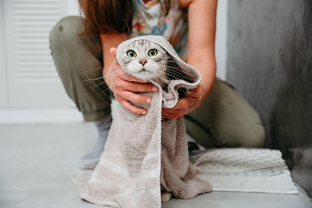
The right habits for looking after your dog's well-being
Taking care of your dog's skin, eyes and ears is essential for their health and well-being.
We are regularly reminded by professionals that the condition of an animal's skin and coat is often a reflection of their health.
The first step in your pet's care routine is regular brushing, whatever the breed or coat type. Regular brushing can be accompanied by a thorough skin examination, to remove dead hair and impurities and encourage hair growth. We recommend that you brush more regularly during the spring and autumn moults, to help your dog shed their winter or summer coat.
Dogs' skin is covered with a surface film that plays an important role in maintaining the skin's microbiome. Contrary to what some people think, and especially if your dog lives in the city, you can wash them regularly as long as you use a specific shampoo for dogs (the pH of their skin is different from that of humans) that is also adapted to any particular skin characteristics they may have.
Dogs exhibit various hair types, each with distinct characteristics. A greasy coat, prone to oiliness, often requires regular grooming. Silky-coated dogs possess smooth, shiny hair that necessitates careful maintenance to prevent tangles. Recognizing healthy hair entails observing qualities such as luster, elasticity, absence of excessive shedding, and a clean, odor-free appearance. Regular brushing, balanced nutrition, and proper hygiene contribute to maintaining a dog's hair health.
Your dog's eyes are a fragile area, prone to irritation and injuries.
If you notice that your dog has red, watery eyes, half-closed eyelids or purulent discharge from the eyes, make an appointment with your vet as soon as possible.
Regularly cleaning your pet's eyes is an essential preventive measure to prevent and/or detect any eye problems. Certain breeds, especially those with prominent eyes, are particularly susceptible to eye problems, so you need to be extra vigilant.
How often you need to clean your dog's eyes depends on their breed and lifestyle. We recommend using a special veterinary cleanser to clean your dog's eyes. Don’t hesitate to consult your specialist.
Dogs' ears are often the site of infection and inflammation. If your pet’s ear canal is sensitive to the touch, smells foul, looks red or their head is tilted to one side, consult your vet.
Dogs are also susceptible to parasitic ear infections. If your pet is suffering from this, they will regularly shake their head and scratch themself with their hind legs. Palpation of the ear canal through the skin triggers scratching, and blackish deposits appear in the ear. If this happens, make an appointment with your vet.
Regular ear care means that this type of problem can be detected and early action taken, before it becomes serious.
You will need to be more vigilant with dogs prone to ear infections, especially those with allergic tendencies, dogs with floppy ears, certain breeds (Cocker Spaniels, Labradors, etc.) and hunting dogs, who are more prone to foreign bodies in their ears.
Trimming inside the ears of dogs with floppy ears improves aeration of the ear canal and reduces the risk of ear infections and the penetration of grass spikelets, particularly in spring.
Regularly inspecting your dog's ears is the best way to ensure they are in good health. It also means you can take appropriate action, if necessary, to prevent your dog from developing more serious health problems such as inflammation or infection.
In some cases, ear infections can occur for reasons beyond your control and with no (or few) prior symptoms. That's why it's a good idea to check your pet's ears regularly and make regular ear cleaning a part of your care routine to help prevent any problems.
It’s sometimes difficult to pinpoint the cause of ear pain or infection in dogs, but there are some factors that can lead to ear problems. For example, if your dog:
- has floppy ears
- swims regularly
- suffers from a diagnosed allergy
- often has dirty or smelly ears
You may suspect ear pain or infection if your dog:
- shakes their head regularly
- scratches their ears
- has red or swollen skin inside the ears
- seems to be in pain around the ear area
- has a foul-smelling ear odour
- has runny ears
- changes their behaviour
- has their ears licked by other animals
It’s important to get in touch with your vet as soon as possible if your pet is showing signs of ear discomfort, is not behaving normally or if you notice an “abnormal” smell in their ears. It's best to seek treatment as soon as possible.
A mild, pH-neutral antibacterial ear cleaner such as EpiOtic can be used as part of a regular ear- cleaning routine or as a complement to most ear treatments. Consult your vet, who will tell you how often to use this type of product.
If you are combining EpiOtic with a prescribed treatment to cure an ear infection, clean your pet's ears with EpiOtic before administering the treatment to ensure that the canal is free of excess earwax, pus and cell debris. Check with your vet whether your pet's ear treatment should be accompanied by regular ear cleaning: they will be able to tell you the best way to proceed.

